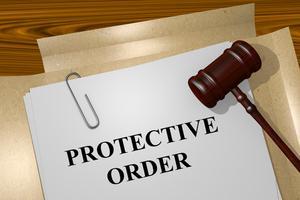Domestic Violence and Orders of Protection
 In the United States, one in three women and one in seven men are victims of domestic violence. Due to fear, embarrassment, or shame, domestic violence incidents are underreported, so the actual statistics are probably higher. The abused, of course, have nothing to be ashamed of as they hold no culpability for the perpetrator's behavior.
In the United States, one in three women and one in seven men are victims of domestic violence. Due to fear, embarrassment, or shame, domestic violence incidents are underreported, so the actual statistics are probably higher. The abused, of course, have nothing to be ashamed of as they hold no culpability for the perpetrator's behavior.
Domestic violence does not discriminate and affects all races, creeds, sexual orientations, and educational and socioeconomic backgrounds. A domestic violence attorney can help victims obtain orders of protection to help safeguard them from abusers.
Domestic violence devastates families and is detrimental to society. It comprises physical violence and many other forms of abuse.
Seven Types of Domestic Violence
-
Physical Abuse – Offenders physically assault victims by any means, such as slapping, punching, shoving, strangling, dragging, pulling by the hair, kicking, stabbing, shooting, suffocating, or strangling.
-
Verbal Abuse – Sometimes considered the most detrimental type of domestic abuse as it aims to diminish the victim’s self-worth, verbal abuse includes an offender screaming, threatening, taunting, demeaning, and belittling the victim. Humiliating the abused in front of family, children, or friends is another common tactic. Verbal abuse goes hand-in-hand with controlling behavior common in abusive relationships.
-
Emotional Abuse – Offenders may threaten violence against the abused or threaten to hurt their loved ones. Emotional abusers may control the relationships between the victims and their children or other family members, such as a concerned sister. They are manipulative, oftentimes causing chaos and manufacturing a crisis. Emotional abusers may divulge secrets or disseminate lies to family members, friends, or coworkers to humiliate the victim.
-
Controlling Behavior – Enraged with jealousy, offenders usually obsess over the partners' former relationships and sabotage the current ones, including those with children, family, friends, and colleagues. An abuser may gaslight or psychologically manipulate the victim so that the victim feels at fault for whatever turmoil or even minor dilemma the abuser created. Offenders may also undermine the victims' talents and achievements to attain authority over their independence and squash their ambitions. Other methods perpetrated by the abuser include controlling what the victim eats, how the victim dresses, who the victim socializes with, and where the victim works.
-
Economic Abuse – Even if not the breadwinner or financial contributor, an economic abuser may seize total control of the family finances to hide, steal, or deny money from the abused. Withholding basic human needs, such as diapers, food, or medicine, is a common maneuver. Offenders may either force partners to work or prohibit them from attending school or work.
-
Sexual Abuse – Any type of sexual assault, including rape and forced sex with a third party, is sexual abuse. Flaunting infidelity and verbalizing derogatory statements about the victim’s appearance are also forms of sexual abuse.
-
Willful Deprivation of a Dependant – When an abusive breadwinner purposely denies dependents of food, clothing, proper hygiene, medical attention, shelter, or safety, this falls under the category of willful deprivation. Again, these are tactics to exert power.
Three Kinds of Orders of Protection
Orders of protection, issued by judges, are legally-binding directives aimed to protect a person from continued domestic violence or the threat of domestic violence. By restricting the alleged offender from physically, verbally, or electronically contacting the victim, these orders help deter domestic abuse. If necessary, orders of protection may also include stipulations on parenting time. During divorce proceedings involving allegations of abuse, the court may appoint a guardian ad litem or child's representative to determine the allocation of parental responsibilities.
Once an order of protection goes into effect, the alleged is bound by law to abide by the order’s provisions. Failure to do so may result in criminal charges.
-
Emergency orders of protection (EOP) - Due to the immediate threat of violence to the abused (petitioner), the abuser (respondent) does not need to know or participate in the EOP hearing. This is called an ex parte hearing. Either the abused or an advocate for the abused provides the sworn testimony necessary for an EOP. The EOP can last up to 21 days and goes into effect the moment a judge approves it. The court then schedules a hearing date for the plenary order.
-
Plenary orders of protection – This order can last up to two years and is issued by a judge after a full hearing, in which both the petitioner and respondent provide testimony and evidence. If the respondent fails to attend the hearing, the plenary order of protection may be automatically issued.
-
Interim order of protection – This order lasts up to 30 days and is implemented during the time between an emergency order and plenary order. The interim order of protection is necessary when a hearing date for the plenary order cannot be set.
Contact a Cook County Domestic Violence Attorney
At The Law Offices of Curtis Bennett Ross, L.L.C., we understand the gravity of domestic violence and the urgency of orders of protection. If you or your children are being abused or threatened, find a safe and secure place, then strategize. Curtis Bennett Ross is a compassionate and reliable divorce lawyer, a court-appointed guardian ad litem, and child's representative. For a free consultation, contact aChicago family law attorney at 312-984-1514.
Sources:
https://www.ilcadv.org/
https://www.illinoiscourts.gov/courts-directory/77/Cook-County-Domestic-Violence-Court/court/
https://www.chicagotribune.com/news/ct-domestic-violence-surge-pandemic-20210611-x3yf773j6zebxalt5wqgas5kyq-story.html
https://icjia.illinois.gov/researchhub/articles/domestic-violence-trends-in-illinois-victimization-characteristics-help-seeking-and-service-utilization

 312-984-1514
312-984-1514

